Welcome back to Changemaker Q& A, everyone. I am Tiyana J, your host and founder of the Humanitarian Changemakers Network. And I’m very keen to dive into today’s question. It’s a very timely topic that we will be discussing. And one that I have been thinking about a lot lately with everything that is going on in the world, we’re going to be talking about the effective use of social media for social change.
When you are a supporter of a particular cause, but not so much in terms of tactics for using social media in like a formal advocacy campaign or anything like that. We’re just talking about kind of like the general use of social media. When we care about a cause, when we see something happening in the world, and we want to be able to kind of do something about it.
And the reason this question is the one that I’m going to be answering today, I actually had a different question. A different topic planned for this week’s episode, but the other day my sister Facetimed me. She was in tears, the poor thing. She lives in a van and travels Australia full time, and since she left on her trip in about January at the start of this year, she’s grown a bit of a following online, and I guess she’s now what you would consider to be an influencer.
She has like over a thousand followers. 100, 000 followers and a very kind of active and engaged audience that enjoy seeing her travel content. And I think that because having an audience is something that is so new to her, she Was really distraught about what she was seeing on social media about the conflict in Palestine and she was very emotional about it, very upset about it.
She kind of wanted to, I think, disengage with what she was seeing because it was upsetting her so much, but at the same time, she felt a degree of responsibility to not remain silent on the issue and It raised a whole lot of kind of complexities and questions about the most effective way to kind of go about using social media in a situation like this.
So my hope is that whenever you might be listening to this episode, whether it is now in the midst of the Israel Palestine conflict, or whether it is in the future and you’re dealing with a different issue of injustice or oppression. Hopefully what we’re going to kind of unpack and explore in this episode will help you to make better decisions about how you use social media for social change.
So There’s a quote that I generally like, and I often see thrown around during times like this. It’s a Desmond Tutu quote, and it goes, If you are neutral in situations of injustice, you have chosen the side of the oppressor. I’ve seen that posted several times in the past fortnight or so, in relation to the conflict in Palestine, and I think it’s important first of all to note that that’s not the full quote.
The quote continues and it says, If an elephant has its foot on the tail of a mouse and you say that you are neutral, the mouse will not appreciate your neutrality. So, I think when we hear the whole quote, it makes a little bit more sense because it’s suggesting that we ought to not stay neutral in situations of injustice, but at the same time, there’s kind of this underlying assumption that staying neutral means that we are allowing the injustice to continue.
And that might be true for the elephant with its foot on the tail of the mouse, but when it comes to posting on social media, it’s not so straightforward. And. It can be really easy for us to think that simply by posting something on social media that we’re doing our bit, we are no longer remaining neutral, and we kind of think it’s the same thing as doing something meaningful.
And I’m not saying that posting on social media does nothing, but I think we need to stop assuming that silence on social media is the same as neutrality. And, you know, we live in this era of slacktivism where it’s common for us to kind of think that when we do something with very little effort or very little commitment by engaging in a political or social cause through something like online petitions or sharing a post online, it makes us feel good and we think that we are doing something.
And we might be, but chances are what we’re doing is incredibly small and it makes us feel so good. And so we assume that if we feel such a high degree of goodness, then we think that we are doing an equivalent amount of good in the world. And I don’t think that is necessarily accurate. At the same time, You know, it’s easy to think that online communication is useless and, you know, posting something or doing something online doesn’t really contribute to change, when it can.
It just contributes to, I think, a different type of change, or it contributes to change in a different way. Something that I always like to kind of remind myself when I’m questioning the effectiveness or the impact of something that I’m looking at. I always have to kind of just ask myself, does this thing have the potential to change people?
And at the end of the day, anything that has the potential to change people has the potential to change the world, I think, because it’s people that change the world. And this is where things like movies and books and art and things like that, I think, really hold the potential to change the world. It’s because…
of how strong of a potential they have to change people, to change the stories people tell themselves about the world, to change the stories that people tell themselves about how the world should be or could be. And online communication does have the potential to do that as well. So it’s important that we can kind of recognize Posting online in situations like this does have the potential to make an impact, particularly if maybe we’re posting online in a way that is recommending people go and support a particular cause financially or go and do something.
offline, that can be really impactful. And at the same time, simply posting so that people become more informed and aware of something does have the potential to change the world. But I think it’s a bit naive to think that just because we are sharing posts or something like that, that we are really kind of contributing to change on the issue in a significantly meaningful way.
So. When it comes to posting online, I wanted to talk about some things that I think we should consider when we are going to do it. And the first thing is to always post online or always share something online with a very clear goal or intention. It’s easy for us to scroll through our feeds, see something that catches our attention or that moves us and we think, oh great, I’m going to share this on my story, I’m going to retweet this, repost this, whatever it might be.
But I think it’s important for us to just stop and think what is my intention behind sharing this? Is the intention to educate and inform Is my intention to encourage them to check out this organization or this platform and perhaps sign a petition or donate their money? Is my intention to get them to be mobilized to engage in some kind of event or some kind of protest or something offline, something in the real world?
I think that if we’re encouraging people, to do something that has that kind of real world tangible impact, that’s always better. If we are posting because we simply want our audience to think we care about an issue or to know where we stand, that’s probably not the most effective use of social media.
We can still do that. We can still post. To tell people where we stand so that we aren’t, you know, remaining neutral, so that we are making sure people know that we care about something, but we’re also doing it in a way that has further people. Thank you. outcomes. They’re kind of just like the unintended consequence of what we’re doing, but the real intention behind what we’re doing is to educate and inform people, to promote, you know, understanding and peace and consensus amongst the general population, whatever it might be.
Something that I think is really important is not to add to the noise. When there is something like the conflict that we’re currently seeing, it’s really important that we don’t post or share content that is just going to add to the existing noise. We want something that is either going to cut through it and, you know, I think the only way you can really cut through the noise is if you’re coming at it from the…
a perspective or from a position where what you have to say is something different or something new than what’s already been said. Maybe you have the ability to make people think differently based on your experience or your expertise, or perhaps if you have a large enough audience and you think that they are more inclined to listen to you and If you have something credible to say and you are a credible figure, then perhaps you posting some kind of original content might be the best way to get through to your audience.
But generally, I think that most of us, on most issues, probably don’t have anything particularly… like unique to say. And what we should be doing instead is amplifying the voices of either experts on the topic or those with lived experience. We often hear the term voiceless used to describe a population that are oppressed or experiencing some kind of injustice, but I think most of the time these communities and these populations aren’t voiceless.
They have a voice. There’s just not enough people listening to them. And so our job, if we are going to be contributing to the discourse on an issue, our job is to amplify their voices, not our own voices. And this is something that I see a lot and it really. a little bit, I think when people go to a protest or something, which is obviously really important.
I think, you know, we should be attending protests. We should be engaging in any kind of direct action that is part of a formal an organized campaign for change. But I see it a lot around Australia day. When allies will attend a rally or a protest against Invasion Day and they’ll post a picture of themselves at the protest holding their sign, their placard, or, you know, they’re just posting pictures and they’re making it about them.
And I think that’s completely missing the point. Go to the protest, go to the rally, be there and offer your physical support. But when it comes to posting online, the thing you should be sharing is the voices of those with lived experience. You should be elevating. The people from that particular community, those who are organizing the rally, those who are speaking out.
Your job online is to amplify their voices, not make it about you. Because when you make it about you, all you’re doing is adding to the noise and you’re diluting the voices of the people that we really need to be listening to. Another tip I would suggest when it comes to posting online is always opt for stories over facts and figures.
Facts and figures can be very convincing, but it’s not going to be enough to motivate people to care enough about the issue or to take action. A lot of the time facts and figures don’t really have any context for us to be able to kind of relate them to something that we’ve maybe experienced ourselves or something that we know enough about to kind of contextualize it in our head and actually realize.
What that issue looks like, feels like, is like in reality. Storytelling is our oldest and most fundamental method of communication as humans. And, you know, when you think about the past, when you think about the present, when you think about the future, you’re doing so in a way that it’s almost like a movie playing out in your head.
And this is why stories are so powerful. It’s because we tell ourselves stories about how we make sense of our own lives and our own identity and our community, the lives of others, and what our future might hold. And facts and figures can communicate the urgency of an issue. I think they can help to quantify the scope or the depth of the issue.
But evolution has wired our brains to be more receptive to storytelling. In their most simplest form, storytelling is essentially a connection of cause and effect patterns. And even though we don’t really live in a world of linear cause and effect patterns, our brains as humans tend to… be far more adjusted to understanding and comprehending linear cause and effect patterns.
And when you tell a story with a beginning and a middle and an end, there’s kind of like a very clear input, process, output, cause and effect pattern happening there. And that is how us humans think. So, when it comes to convincing people to care about an issue or when you’re sharing something, you want to share a story because people can relate to stories.
People might not have ever experienced anything like what is happening in Palestine at the moment, but when you’re sharing a story about a young child or… A teenage girl who just wants to get her education or whatever it might be. We can all relate to that. Whether you’re a teenage girl or not, you know, you can relate to this idea of being a teenager, of wanting to get an education, or you know somebody who falls into that kind of category.
And that’s why stories can be so compelling. We can always relate someone else’s story to our own. And with that said, that is why I think that… Stories are one of the most powerful tools when it comes to social change. And even if we don’t have the lived experience of something, when we experience the world, when we travel, when we engage in other people’s stories through books and movies and things like that, that Kind of broadens our scope of other people’s stories and it just allows us to relate to other people better and develop a deeper connection and level of understanding to others.
So, where possible, I would really recommend sharing stories on social media. In particular the most effective stories tend to be a story that has an individual person, one person at the center of it. There’s a phenomenon called the identifiable victim effect, and it’s essentially this idea that we are far more moved by the story of
the way we, I guess. Kind of process information as humans is through stories. We hear something about another person or something that’s happening somewhere else or a pressing issue, whatever it might be. And the way we kind of understand it is by filtering it and Comparing it and contrasting it with our own experiences and that’s why stories are so much more effective than facts or figures.
When you hear a fact or figure that has very little context there’s nothing that you can really relate it to but when you hear a story that kind of tells you a little bit more about what those facts and figures are illustrating. With story, you can relate it to your own experience, whether or not you’ve actually got that lived experience yourself or whether you can kind of just compare it and contrast it with your own story, whether you have traveled and gained experience and you can kind of recognize what that might be like, whether you’ve read a book or watched a movie and you’ve kind of got other people’s stories to kind of compare it and contrast it to.
Stories are always going to be the most powerful way to move people and help them actually understand an issue. So I really encourage you to share stories on social media. There is a lot of research that suggests a story with a single person at the center of it is more powerful than a story about a group of people.
I think this phenomenon is called the identifiable victim effect and it essentially means that When we hear a story about one person experiencing some kind of injustice, it’s going to motivate us to act, it’s going to mobilize us more, it’s going to move us more than a story about five people or 50 people that have experienced the exact same thing.
I don’t like the term identifiable victim effect in the same way that I would recommend you don’t share stories, put people at the center of it and paint them as helpless victims. I think that even when people are experiencing some kind of injustice or inequality, you know, they aren’t a victim. They’re not helpless.
They are autonomous people who have dignity and respect. They are just kind of within a system, an oppressive system or some kind of like culture that is making them more vulnerable. But I think it’s important to not paint people as these helpless victims. Another thing that I personally think is really important and might be a little bit controversial but I think that when we’re sharing things on social media and just in our approach to conversations for change or even just thinking about issues, it’s really important that we separate oppressive systems and oppressive ideas from people.
It can be really hard to look at, you know, people who are perpetuating an oppressive system, uh, and like not have hatred towards them or not kind of see them as the enemy. An example that I’ll use is Nazis in World War II. It can be really easy to look at somebody who was a Nazi and think, what a horrible person, how could somebody do such a thing, like they are an evil person, but I think the only way we can kind of create the change that we want to see in the world is when we can separate the people perpetuating those systems and ideas from the systems and ideas themselves.
Because yes, these people did some horrible things, and perhaps they are horrible people, but the reason they were that way was because of the story that they were being told about the world and how the world should be. And because they bought into that story. And if you can just separate the people from the system, it’s really crucial.
This is something that I think Martin Luther King Jr. and Gandhi both talk about. And… It’s this idea that, you know, there are no evil people, only evil forces and evil institutions. That is something that Martin Luther King taught and something that I found really hard to, I guess, understand when I first started reading the teachings of Martin Luther King Jr.
and learning a little bit more about him. It’s hard to look at something and say, well, you know, arguably, the people that are perpetuating this system and doing this thing are bad people, but The kind of social change that the world needs, the kind of transformative change can only be achieved when the way in which we engage in the work of change is reflective of the world that we want to create.
And if you’re engaging in the work of change from a position of hatred towards other people, or the need to kind of separate people in this us versus them mentality, or see, other people as objects that are kind of like against your cause, then you’re going to continue to perpetuate those same ideas, that same scarcity mindset, all of that stuff, which is the very thing that is creating the problems that exist in the world.
There is an episode in season one of the podcast that I would recommend maybe going back and listening to, we interviewed John Cook, the founder of Skeptical Science, which is a platform that debunks all of the climate change misinformation and science out there, and he spoke about it. And I think that’s great.
The need to engage in discussions about climate change in a way where you’re not being political and, you know, there’s nothing wrong with being political per se, but when you post about something, when you have a conversation with someone, do it as if you are against the thing that they’re doing, that is wrong, the thing that is morally or ethically wrong, not the political party, not the country, not the people themselves.
You can… Be critical of a particular policy without being critical of the people or the party that created that policy. You can be critical of something because it is a violation of human rights without necessarily making it that you are against the perpetuators of that injustice and those who are not respecting human rights.
It’s hard to do but it is really important. If you have any questions about that definitely feel free to ask them because this is something that I have really been learning about a lot, something that I have been working on over the past like two years or so, and it’s a challenge, but I think it is essential if we do want to create the kind of change that the world needs.
Another piece of advice I would give is to just be really mindful. Be mindful in what you are posting, but also mindful in what you’re consuming. If consuming content about a particular issue is overwhelming you to the point where it is physically upsetting you, Or the point where you don’t think that you can engage in healthy conversations or discussions about it, then take a break.
I don’t disagree with this notion that I see around on social media a lot. And people are always saying things like, you know, Humans, the human brain wasn’t designed to deal with the amount of news and information that we have access to today. We… can turn on our phones, we can turn on our TV, open up a newspaper, whatever it might be, and be informed about all of the terrible things that are happening in the world.
And we weren’t able to do that a hundred years ago, two hundred years ago, let alone a thousand years ago. What I don’t agree with is this idea that we should completely disconnect from The news. I think that part of living in a globalized world means we need to be aware of what is happening in that globalized world.
But the trick is to just do it mindfully. The trick is to be intentional about when you consume news content, what type of news content you consume, who you’re consuming content from, and recognizing how it’s making you feel. Being aware of the reactions that you have to it. Whether you see something and it immediately upsets you or angers you, whether you read something and you immediately agree or disagree with it.
Part of being a better change maker is beginning to understand others and others perspectives and ourselves as well. So when you’re consuming something, just being mindful about how it’s making you feel, how it maybe aligns or does not align with your story, the story you’ve told yourself about a particular issue or the world.
And we can observe without being judgmental. I think that is a skill that all changemakers should be able to have in their changemaking toolkit. I always advocate keeping things solutions focused. It’s important to educate people about what is happening and inform people about an issue, but it’s just as important to do so in a way that offers a solution or offers some kind of hope.
So with that said, I want to wrap up this episode by sharing a couple of frameworks that. I’ve found really helpful. These are two frameworks that I learned when I was working with Amnesty International, and these are frameworks that can be applied to either social media posts and content that you share, or just kind of general conversations that you might have with people.
when you’re engaging in conversations for change. The first framework is the outrage hope action framework. So this three part framework essentially offers an effective way for you to present information, present a story about a particular issue to your audience or to other people in a way that keeps it a little bit solutions focused.
So The first step is outrage. So this is offering some kind of motivator or a way for people to overcome their fear. You want to show something that might be a little bit shocking, that might make people, you know, might get their attention, some kind of like hook. Then… The second step is to hope. We always want to offer hope.
We want to give people a reason to care about this issue, a reason to come on board, or a way to maybe overcome any apathy that they might have towards the issue. And the final step is action. You want to offer people some kind of action that they can take or something that they can do that is a step in that right direction.
We’ve offered them hope and now we wanna show them that there is a way we can actually get there. So it’s getting people to maybe make a concrete commitment, no matter how small it might be. And depending on whether you are posting online or whether you are having a conversation with someone, you could use questions in this framework or comments.
So questions are good if you want to encourage a conversation with others which can be very constructive, but. I would only use questions if you are confident enough to actually engage in a conversation with people who may have differing views. Otherwise, particularly when you’re posting on social media, I would just stick to using comments that align with this framework.
So for outrage, you could use a question like, how do you feel about This particular issue. What do you think about what you’re seeing in this video? Are you concerned about this particular human rights violation? Do you think it is right that people are being oppressed or experiencing some kind of injustice?
Or, you can use comments. I can’t imagine living under these conditions. It just seems so unjust to me that this is happening. Then, so if you’re using questions, you can ask questions like, do you think it’s important that we try and change this situation? Do you think it would make a difference if we were able to do something.
You could use comments by saying, you know, there’s a lot of evidence to actually support that we can change this, or it’s completely possible if we do x that we will get y. And then finally we have action. So you can use questions like, will you sign this petition? Will you do something? Or you can simply use a comment.
Head to the link in my bio, check out this platform to learn more, whatever it might be. So, the Outrage, Hope, Action framework is a really useful framework for getting people to engage in content in a kind of constructive way. And the next framework is one that can be used when you are having a conversation, particularly if you need to handle any objections people might have.
So, this framework is the Explore. Equalize, elevate framework. So explore is about you’re exploring, you’re just listening to the objection people might have, you’re trying to ask questions to really understand and identify what their concern or issue is. People will often say. That they’re opposing something for one reason, but when you kind of get to the heart of why they feel that it might be something different.
So you’re really trying to understand why they feel that way as opposed to just what they think or feel. It’s always important to just clarify to people what their concern is. Don’t assume that you know Or understand what their perspective is, just ask questions being like, Am I right in saying that you think this or you believe this for this reason?
So always just asking questions and making sure that you kind of clarify with them what it is that they think. Then, We have the equalize step. Equalizing is about trying to get on the same level as that person. So we’re saying, you know what, I understand why you would feel that way. I’ve seen the things that you’ve seen.
I’ve read a lot of the things that you’ve read. I completely understand why you feel that way. Maybe you would say you know, I actually thought that initially to you want to build rapport with the person and you want to empathize with them. So you actually want to just. You don’t just want to be tolerating people’s views or opinions that might be different to yours.
You actually want to understand them, and that’s really hard. That goes back to what I’ve been talking about, about this idea of trying to separate ideas and systems from the individual people. You If, I think if you don’t have the ability to understand where someone is coming from, then you probably shouldn’t be engaging in this type of deep conversation.
You want to really understand them, and somebody could have an opinion that is so fundamentally against what you stand for, and it can be really hard to understand them. And understanding involves, I think, a level of mutual respect. It’s about saying, okay, we have different views, we have different opinions, but I understand your perspective and I respect you and I respect that you hold that story.
The aim of this step is to really, I guess, reduce hostility that the other person might have to you, but again, it’s really about just understanding and empathizing with them. And the third step in this framework is to elevate. So you want to continue to pose questions that are going to allow the other person to maybe change their position or just review what they think.
This is something that I think it was Plato. Plato’s work or any of the philosophers that use Socratic dialogue does really well. Socratic dialogue is the technique that was used by the ancient Greek philosophers who wrote about Socrates and they did so. through conversation. So if you read the work of Plato, it’s actually written as a fictional conversation between different characters.
And it’s the going back and forth and the asking questions and the Getting to the heart of why each other kind of thinks that particular way and developing that level of understanding that allows the characters to eventually find the desired viewpoint or outcome, which is usually the one that is the most just, the most moral.
So this is what we’re trying to do with the Explore, Equalize, Elevate framework. You want to continue to pose questions to people. You’re not saying. Ah, but what about blah blah blah blah blah blah blah blah blah in a way that’s gonna kind of alienate the other person? You want to be asking questions by saying, okay, so what you’re saying is that X Y Zed and you want to present The contradictions or the inconsistencies in their viewpoint back to them by asking them just to clarify, like, is this what you’re saying?
And then they’ll say, Oh, well, no, but, and it goes on like that. You want to help identify alternative viewpoints with them and. You ultimately want to assist them in not only changing their attitude to the issue, but making some kind of commitment. That could be a commitment to take a particular action, or just a commitment to learn more, to engage with alternative viewpoints.
So that’s the Explore, Equalize, Elevate framework. So again, those are two frameworks that you can use when you are having conversations with people or just posting online. begin to use social media as a tool for social change. I hope this episode was useful to anyone listening. If you have any questions about anything that I discussed in this episode or anything related to social change that you would want me to address, definitely ask your questions.
You can ask directly on Spotify or YouTube if you’re watching this episode. Or if you are listening, you can head to our website, humanitarian changemakers. net forward slash podcast. And you can ask your questions there. You have the option to ask your questions anonymously and any questions that get answered.
We will send you, if you ask that question, some changemaker code goodies as a thank you. As always, you can connect with us on Instagram at humanitarianchangemakers, or you can connect with me personally at @tiyanaj. And I look forward to connecting with you all and seeing all the incredible things that you are doing out in your community to make change happen.
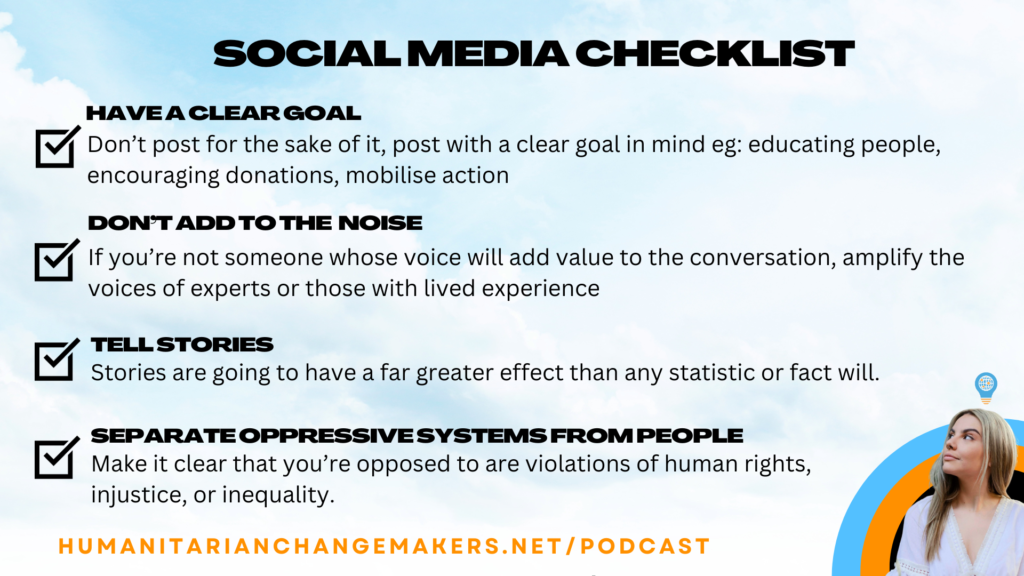
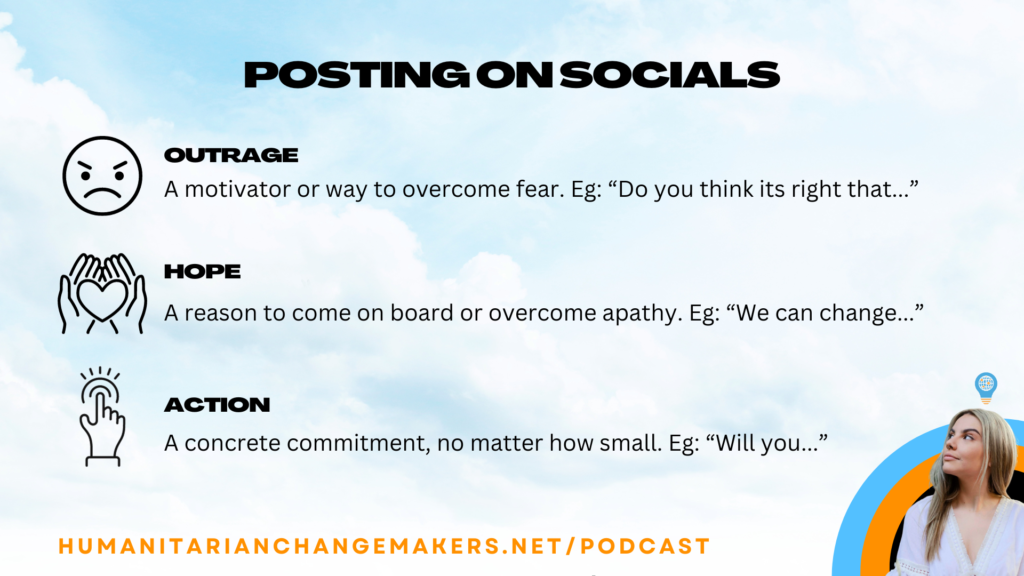
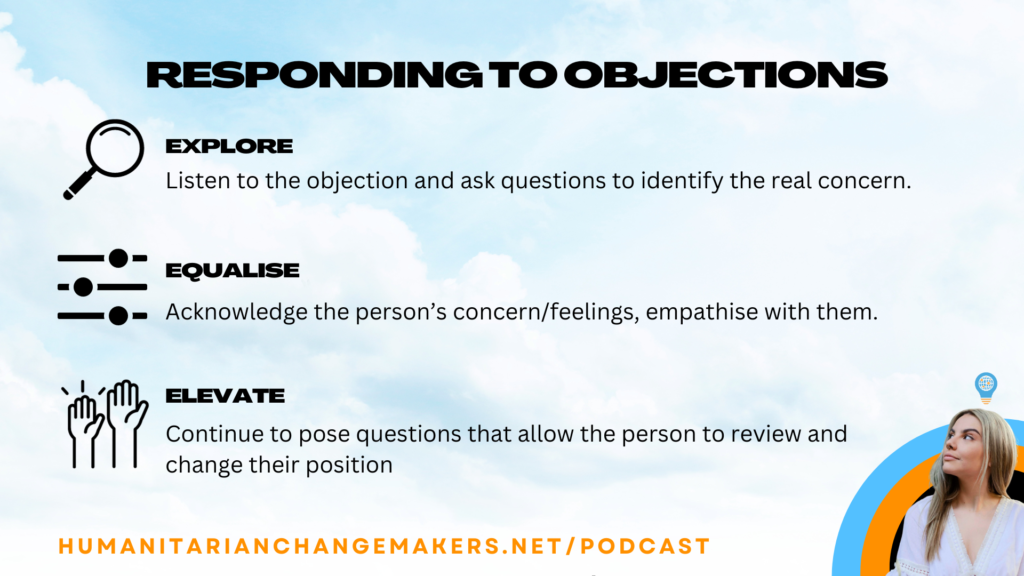
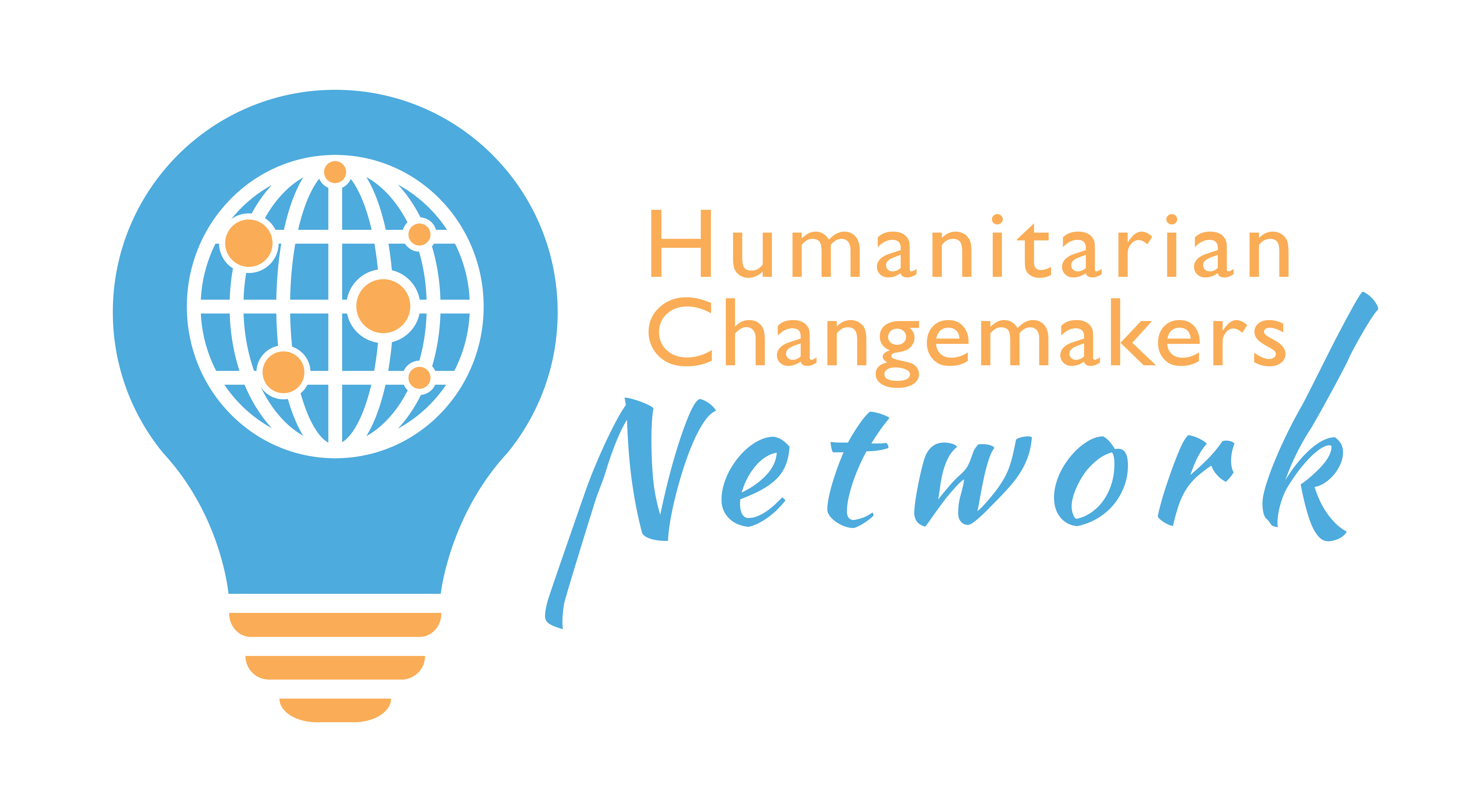
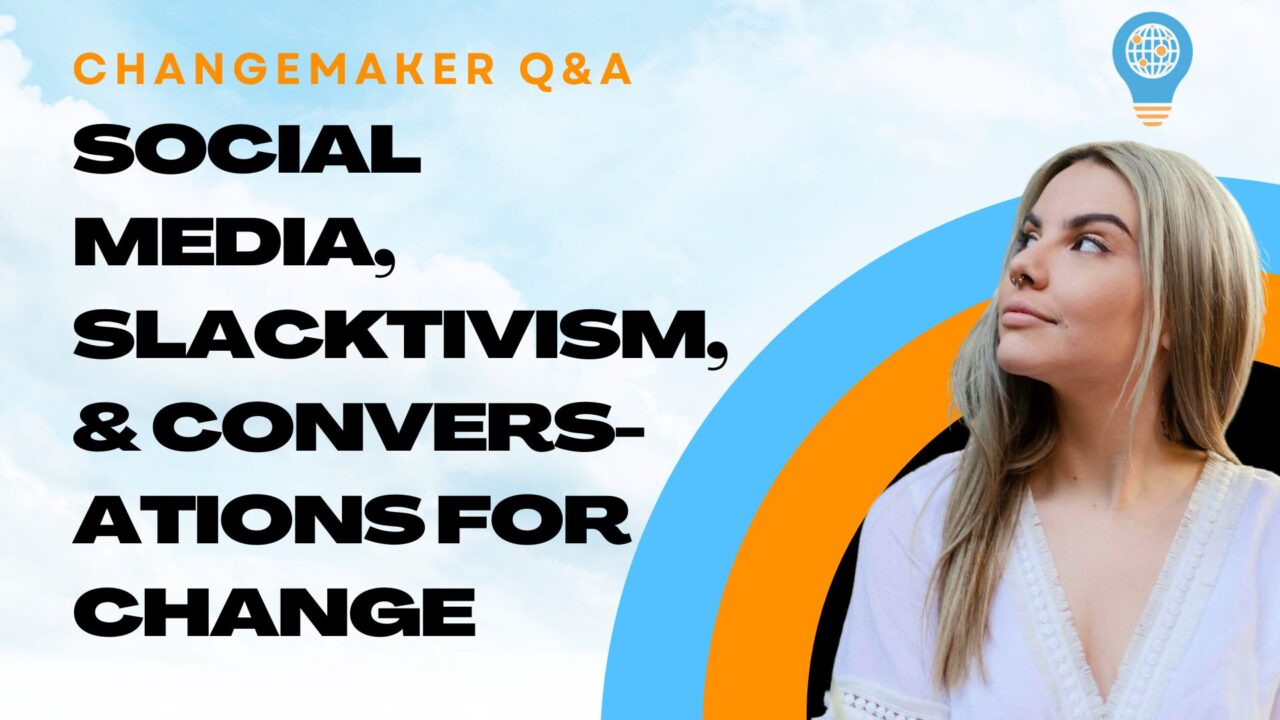

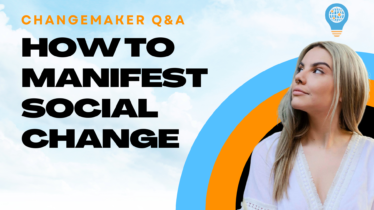
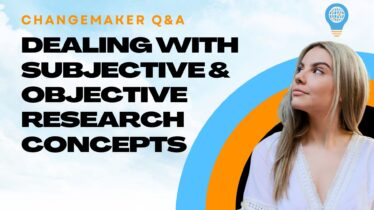
Navigating These Tough Times with a Solutions-Focused Mindset - Humanitarian Changemakers Network
15/11/2023 @ 6:17 PM
[…] some useful tips and frameworks to help her, and shared them all in this week’s podcast episode Leveraging Social Media for Social Change for you to learn […]